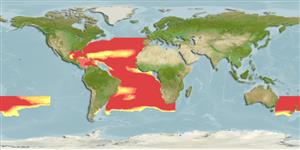Common names from other countries
>
Stomiiformes (Lightfishes and dragonfishes) >
Stomiidae (Barbeled dragonfishes) > Melanostomiinae
Etymology: Leptostomias: Greek, leptos = thin + Greek, stoma = mouth (Ref. 45335).
More on authors: Regan & Trewavas.
Environment: milieu / climate zone / depth range / distribution range
Ecologia
marinhas. Tropical; 45°N -
Eastern Atlantic: Azores south to Mauritania. Western Atlantic: from about 30°N to 24°N between 70°W and 60°W (Ref. 4740). Tentatively identified in the Indian and Pacific. Status of this species is not yet firmly established.
Tamanho / Peso / Idade
Maturity: Lm ? range ? - ? cm
Max length : 37.6 cm SL macho/indeterminado; (Ref. 4468)
Descrição breve
Chaves de identificação | Morfologia | Morfometria
Raios dorsais moles (total) : 19; Raios anais moles: 23. Body very elongate and slender. Short, blunt nonprotrusible snout. Long chin barbel bearing series of filaments on stem (Ref. 37039).
Life cycle and mating behavior
Maturities | Reprodução | Spawnings | Egg(s) | Fecundities | Larvas
Gibbs, R.H. and M.A. Barnett, 1990. Melanostomiidae. p. 308-337. In J.C. Quero, J.C. Hureau, C. Karrer, A. Post and L. Saldanha (eds.) Check-list of the fishes of the eastern tropical Atlantic (CLOFETA). JNICT, Lisbon; SEI, Paris; and UNESCO, Paris. Vol. 1. (Ref. 4468)
Categoria na Lista Vermelha da IUCN (Ref. 130435)
CITES (Ref. 128078)
Not Evaluated
Ameaça para o homem
Harmless
Utilização humana
Ferramentas
Relatórios especiais
Descarregue XML
Fontes da internet
Estimates based on models
Preferred temperature (Ref.
115969): 17.6 - 28, mean 25.4 (based on 478 cells).
Phylogenetic diversity index (Ref.
82804): PD
50 = 0.5002 [Uniqueness, from 0.5 = low to 2.0 = high].
Bayesian length-weight: a=0.00302 (0.00117 - 0.00783), b=3.12 (2.89 - 3.35), in cm Total Length, based on LWR estimates for this (Sub)family-body shape (Ref.
93245).
Nível Trófico (Ref.
69278): 4.5 ±0.80 se; based on food items.
Resiliência (Ref.
120179): Médio, tempo mínimo de duplicação da população 1,4 - 4,4 anos (Preliminary K or Fecundity.).
Fishing Vulnerability (Ref.
59153): Moderate vulnerability (36 of 100).
